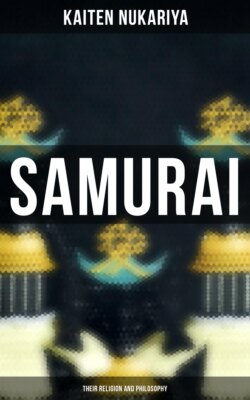Читать книгу Samurai: Their Religion and Philosophy - Kaiten Nukariya - Страница 5
На сайте Литреса книга снята с продажи.
1. Origin of Zen in India.
ОглавлениеTo-day Zen as a living faith can be found in its pure form only among the Japanese Buddhists. You cannot find it in the so-called Gospel of Buddha anymore than you can find Unitarianism in the Pentateuch, nor can you find it in China and India any more than you can find life in fossils of bygone ages. It is beyond all doubt that it can be traced back to Shakya Muni himself, nay, even to pre-Buddhistic times, because Brahmanic teachers practised Dhyana, or Meditation,15 from earliest times.
"Compressing his breathings let him, who has subdued all motions, breathe forth through the nose with the gentle breath. Let the wise man without fail restrain his mind, that chariot yoked with vicious horses.
"Let him perform his exercises in a place level, pure, free from pebbles, fire, and dust, delightful by its sounds, its water, and bowers; not painful to the eye, and full of shelters and eaves.
"When Yoga, is being performed, the forms which come first, producing apparitions in Brahman, are those of misty smoke, sun, fire, wind, fire-flies, lightnings, and a crystal moon.
"When, as earth, water, light, heat, and ether arises, the fivefold quality of Yoga takes place, then there is no longer illness, old age, or pain for him who has obtained a body produced by the fire of Yoga.
The first results of Yoga they call lightness, healthiness, steadiness, a good complexion, an easy pronunciation, a sweet odour, and slight excretions "(Cvet. Upanisad, ii. 8-13).
"When the five instruments of knowledge stand still together with the mind, and when the intellect does not move, that is called the highest state.
"This, the firm holding back of the senses, is what is called Yoga. He must be free from thoughtlessness then, for Yoga comes and goes" (Katha Upanisad, ii. 10, 11).
"This is the rule for achieving it (viz., concentration of the mind on the object of meditation): restraint of the breath, restraint of the senses, meditation, fixed attention, investigation, absorption-these are called the sixfold Yoga. When beholding by this Yoga, be beholds the gold-coloured maker, the lord, the person, Brahman, the cause; then the sage, leaving behind good and evil, makes everything (breath, organs of sense, body, etc.) to be one in the Highest Indestructible (in the pratyagatman or Brahman) " (Maitr. Upanisad, vi. 18).
"And thus it has been elsewhere: There is the superior fixed attention (dharana) for him-viz., if he presses the tip of the tongue down the palate, and restrain the voice, mind, and breath, he sees Brahman by discrimination (taraka). And when, after the cessation of mind, he sees his own Self, smaller than small, and shining as the Highest Self, then, having seen his Self as the Self, he becomes Self-less, and because he is Self-less, he is without limit, without cause, absorbed in thought. This is the highest mystery—viz., final liberation " (Maitr. Upanisad, vi. 20).
Amrtab. Upanisad, 18, describes three modes of sitting-namely, the Lotus-seat (Padmasana), the sitting with legs bent underneath; the mystic diagram seat (Svastika); and the auspicious-seat (Bhadrasana);—while Yogacikha directs the choice of the Lotus-posture, with attention concentrated on the tip of the nose, hands and feet closely joined.
But Brahmanic Zen was carefully distinguished even by early Buddhists16 as the heterodox Zen from that taught by the Buddha. Our Zen originated in the Enlightenment of Shakya Muni, which took place in his thirtieth year, when he was sitting absorbed in profound meditation under the Bodhi Tree.
It is said that then he awoke to the perfect truth and declared: "All animated and inanimate beings are Enlightened at the same time." According to the tradition17 of this sect Shakya Muni transmitted his mysterious doctrine from mind to mind to his oldest disciple Mahakacyapa at the assembly hold on the Mount of Holy Vulture, and the latter was acknowledged as the first patriarch, who, in turn, transmitted the doctrine to Ananda, the second patriarch, and so till Bodhidharma, the twenty-eighth18 patriarch. We have little to say about the historical value of this tradition, but it is worth while to note that the list of the names of these twenty-eight patriarchs contains many eminent scholars of Mahayanism, or the later developed school of Buddhism, such as Acvaghosa,19 Nagarjuna,20 Kanadeva,21 and Vasubhandhu.22
